
Megatherium is an extinct genus of ground sloths endemic to South America that lived from the Early Pliocene through the end of the Pleistocene. It is best known for the elephant-sized type species M. americanum, native to the Pampas through southern Bolivia during the Pleistocene. Various other species belonging to the subgenus Pseudomegatherium ranging in size comparable to considerably smaller than M. americanum are known from the Andean region.
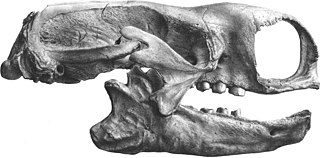
Mylodon is a genus of extinct ground sloth belonging to the family Mylodontidae, known from southern South America. With a total length of 3 to 4 m and a body mass of 1-2 tonnes, it is one of the largest mylodontids.

Ground sloths are a diverse group of extinct sloths in the mammalian superorder Xenarthra. Ground sloths varied widely in size, with the largest, belonging to genera Megatherium, Lestodon, and Eremotherium, being around the size of elephants, with body masses of around 4 tonnes. Ground sloths are a paraphyletic group, as living tree sloths are thought to have evolved from ground sloth ancestors.
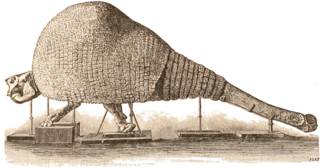
Doedicurus is an extinct genus of glyptodont from North and South America containing one species, D. clavicaudatus. Glyptodonts are a member of the family Chlamyphoridae, which also includes some modern armadillo species, and they are classified in the superorder Xenarthra alongside sloths and anteaters. Being a glyptodont, it was a rotund animal with heavy armor and a carapace. Averaging at an approximate 1,400 kg (3,100 lb), it was one of the largest glyptodonts to have ever lived. Though glyptodonts were quadrupeds, large ones like Doedicurus may have been able to stand on two legs like other xenarthrans. It notably sported a spiked tail club, which may have weighed 40 or 65 kg in life, and it may have swung this in defense against predators or in fights with other Doedicurus at speeds of perhaps 11 m/s.
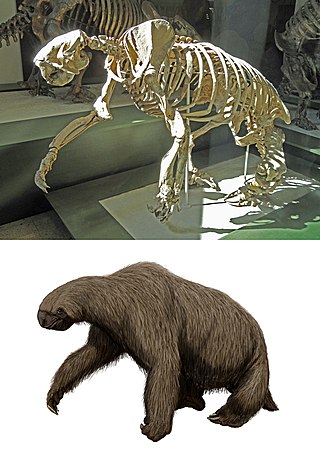
Megalonychidae is an extinct family of sloths including the extinct Megalonyx. Megalonychids first appeared in the early Oligocene, about 35 million years (Ma) ago, in southern Argentina (Patagonia). There is, however, one possible find dating to the Eocene, about 40 Ma ago, on Seymour Island in Antarctica. They first reached North America by island-hopping across the Central American Seaway, about 9 million years ago, prior to formation of the Isthmus of Panama about 2.7 million years ago. Some megalonychid lineages increased in size as time passed. The first species of these were small and may have been partly tree-dwelling, whereas the Pliocene species were already approximately half the size of the huge Late Pleistocene Megalonyx jeffersonii from the last ice age.

Glossotherium is an extinct genus of large mylodontid ground sloths of the subfamily Mylodontinae. It represents one of the best-known members of the family, along with Mylodon and Paramylodon. Reconstructed animals were between 3 and 4 metres long and possibly weighed up to 1,002.6–1,500 kg. The majority of finds of Glossotherium date from the Middle and Upper Pleistocene, around 300,000 to 10,000 years ago, with a few dating older, as far back Pliocene, about 3.3-3 million years ago. The range included large parts of South America, east of the Andes roughly from latitude 20 to 40 degrees south, leaving out the Amazon Basin in the north. In western South America, finds are also documented north of the equator. The animals largely inhabited the open landscapes of the Pampas and northern savanna regions.
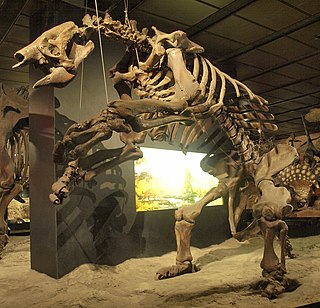
Eremotherium is an extinct genus of giant ground sloth in the family Megatheriidae. Eremotherium lived in southern North America, Central America, and northern South America from the Pliocene, around 5.3 million years ago, to the end of the Late Pleistocene, around 10,000 years ago. Eremotherium was one of the largest ground sloths, with a body size comparable to elephants, weighing around 4–6.5 tonnes and measuring about 6 metres (20 ft) long, slightly larger than its close relative Megatherium.

Paramylodon is an extinct genus of ground sloth of the family Mylodontidae endemic to North America during the Pliocene through Pleistocene epochs, living from around ~4.9 Mya–12,000 years ago.

Glyptodon is a genus of glyptodont, an extinct group of large, herbivorous armadillos, that lived from the Pliocene, around 3.2 million years ago, to the early Holocene, around 11,000 years ago, in Brazil, Uruguay, Paraguay, Bolivia, Peru, Argentina, and Colombia. It is one of, if not the, best known genus of glyptodont. Glyptodon has a long and storied past, being the first named extinct cingulate and the type genus of the subfamily Glyptodontinae. Fossils of Glyptodon have been recorded as early as 1814 from Pleistocene aged deposits from Uruguay, though many were incorrectly referred to the ground sloth Megatherium by early paleontologists.

Catonyx is an extinct genus of ground sloth of the family Scelidotheriidae, endemic to South America during the Pliocene and Pleistocene epochs. It lived from 2.5 Ma to about 10,000 years ago, existing for approximately 2.49 million years. The most recent date obtained is about 9600 B.P.

Mylodontinae is an extinct subfamily of ground sloths that lived from the Early Miocene to the Early Holocene epochs.
Lestobradys is an extinct genus of ground sloth, which existed in Uruguay during the Late Miocene period; Huayquerian in the South American land mammal age (SALMA). The type species is L. sprechmanni, found in the Camacho Formation of Uruguay.
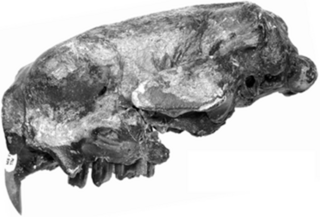
Ahytherium is an extinct genus of megalonychid sloth that lived during the Pleistocene of what is now Brazil. It contains a single species, A. aureum.

Valgipes is an extinct genus of scelidotheriid ground sloth, endemic to intertropical Brazil and Uruguay during the Late Pleistocene. Thought to have been a forest-dwelling browser, Valgipes is a monotypic genus with a complex and long taxonomic history, and is a close relative of Catonyx and Proscelidodon.
Archaeomylodon is an extinct genus of mylodontine ground sloths that lived during the Middle Pleistocene of what is now Argentina. It is known so far only from a single skull, which in its dimensions corresponds to those of the giant Lestodon. However, the skull differs from this one by its narrower and higher snout. In addition, the anterior canine teeth, which are usually large in many mylodonts, are greatly reduced. The find comes from the Pampa region of South America and was deposited in about 700,000 years old sediments.
Urumacotherium is an extinct genus of ground sloths of the family Mylodontidae. It lived from the Middle Miocene to the Early Pliocene of what is now Brazil, Peru and Venezuela.
Simomylodon is an extinct genus of ground sloths from the family Mylodontidae. It lived from the Late Miocene to the Middle Pliocene of what is now Bolivia and Argentina, 5.3 to 2.8 million years ago. The most important find material comes from the central Altiplano in Bolivia and includes several skulls and dentition remains. Thus, the so far documented body skeleton is the best known and most significant of a Miocene representative of the Mylodontidae. On the basis of the remains, it can be concluded that it is a rather small member of the Mylodontidae. The construction of the limbs supports ground-dwelling locomotion, but this does not exclude occasional digging or climbing. The type and only known species is Simomylodon uccasamamensis.
Bolivartherium is an extinct genus of mylodontine mylodontid sloth that lived during the Late Miocene and Late Pliocene in what is now Venezuela. Fossils have been found in the Codore and Urumaco Formations of Venezuela.
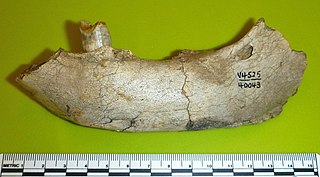
Magdalenabradys is an extinct genus of mylodontid ground sloths that lived during the Middle Miocene and Early Pliocene of what is now Colombia and Venezuela. Fossils have been found in the Villavieja Formation of the Honda Group in Colombia, and the Codore and Urumaco Formations of Venezuela.

Ortotherium is a genus of megalonychid ground sloth from the Late Miocene Ituzaingó Formation of Entre Rios Province, Argentina. Although many species were described, the only valid species of the genus is Ortotherium laticurvatum, with many species being junior synonyms. Ortotherium is known from very fragmentary material, all of which is material from the mandible and teeth. The holotype of O. laticurvatum consists of an incomplete left dentary that had been unearthed from a series of sediments known as ‘Conglomerado osifero’ in Paraná, Argentina. Argentina paleontologist Florentino Ameghino named the species in 1885, though he would go on to name four more, invalid, species of the genus. One species however, O. brevirostrum, has been reclassified as Mesopotamocnus.



















